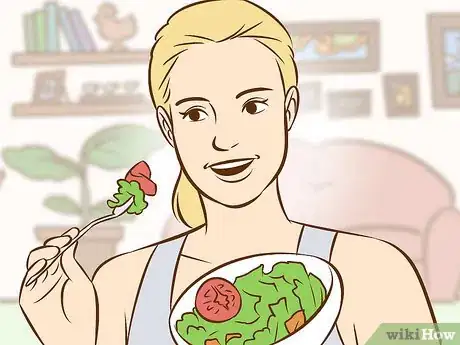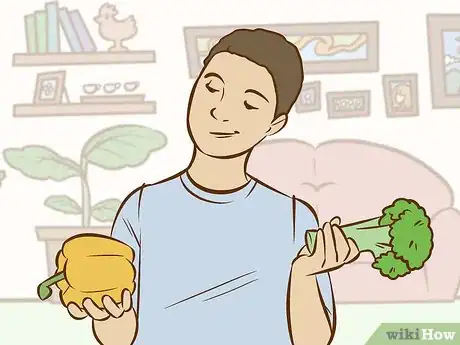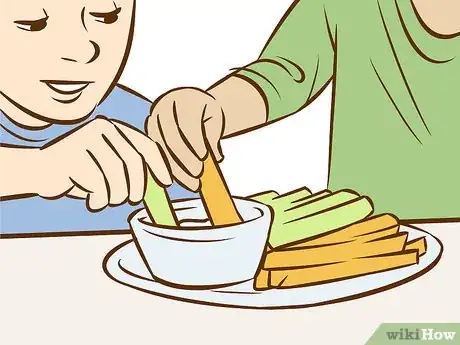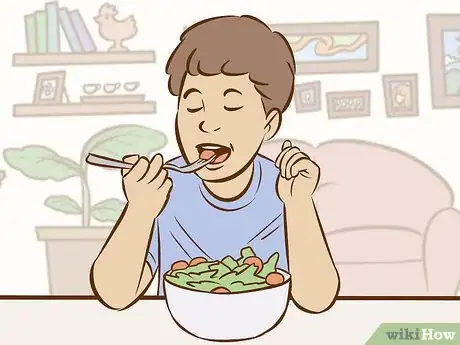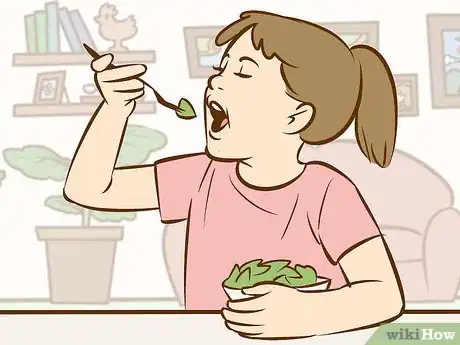This article was co-authored by Amy Chow. Amy Chow is a Registered Dietitian and the Founder of Chow Down Nutrition, a family and child nutrition consulting service in British Columbia (BC), Canada. With over nine years of experience, Amy has a special interest in pediatric nutrition, food allergy management, and eating disorder recovery. Amy holds a Bachelor’s degree in Nutritional Sciences from McGill University. She gained her clinical experiences at residential and outpatient eating disorder treatment programs as well as for BC Children’s Hospital before starting her own business. She has been featured on Find BC Dietitians, Dietitians of Canada, Food Allergy Canada, Recovery Care Collective, Parentology, Save on Foods, National Eating Disorder Information Centre (NEDIC), and Joytv.
This article has been viewed 76,630 times.
As a parent, one of the most important things you can do for your child's well-being is ensure they eat a healthy, balanced diet. Maybe had one of those weeks where the only green thing that’s gone into your child’s mouth is a green toy? You might already know how difficult it can be to get children to eat even the smallest spoonful of spinach, let alone the recommended five portions of vegetables and fruit a day. Fortunately, there are many easy ways to serve vegetables and fruits to your children, that should get them eating their five plus a day.
Steps
Setting a Good Example
-
1Let your kids see you eating healthy foods. If parents are routinely eating and snacking on unhealthy foods, how can children be expected to do any differently? Set a good example by eating the same foods you want your kids to eat. That will help them learn healthy eating habits, and it will make your children more likely to try the foods themselves.[1]
- It is most important to eat plenty of vegetables and fruits yourself. If you model positive behaviors, chances are your kids will copy you. Watch your body and facial expression as well when you try something new.
-
2Offer your children fruit and vegetables frequently. One of the best ways to help your kids learn to eat fruits and vegetables is to serve them with meals and snacks. Being more familiar with these foods will help your child feel more confident about trying them.[2]Advertisement
-
3Expect some resistance and be ready to deal with it. Children typically do not like changes being made to their routines, so expect children to express their dislike to newly implemented changes in the family meal plan. Calmly explain that “this is what we’re having for dinner”, and if children adamantly refuse to eat the planned meal, simply cover it and save it for when they say they’re hungry. If they try it and don't like it, or if they completely refuse to, allow them to make something else to eat. Remember, your home is not a cafeteria-style restaurant where children dictate what they will or will not eat. When the child later says they are hungry, simply say “Well that’s good because I saved your dinner for you”, then reheat as needed.
-
4Explain to children what each vegetable contains by way of providing healthy benefits. For example, carrots have vitamin A which is good for skin and eyes. Make the connections between food and what it does for our bodies.
-
5Get the children involved with kitchen preparation. For example, have them help when making salads or main meals together. They will be able to recognize what they are eating if they get to see it and feel it. It's also a great chance to discuss the food and get to understand its value better.
- For instance, you might let small children help wash fruits and vegetables, while older children may be able to help with chopping them.[3]
Using Vegetables and Fruit as Snacks
-
1Choose healthy snacks for children such as fresh fruit and vegetables with tasty dips. Keep healthy snacks well-stocked at home, readily available and easily accessible for children to grab. Save cookies and other sugar coated treats for an occasional sweet treat or special occasions. Never get into the habit of giving children cookies or other sugary treats when the family meal is being prepared or is almost ready to be served. Consider offering a couple of bites of the vegetables or salad already planned for the meal to tide them over.
-
2Take advantage of after school hunger. When your children come home, have a plate ready with crunchy celery, carrots, and cucumbers on it. Serve it with dip if it makes it more enticing for them.
-
3Have fresh, already cut vegetables for car trips or walks. Kids eat a lot when they are hungry or even bored, and if it's already prepared, they'll easily snack on the healthy foods.
Making Vegetables and Fruits More Appealing
-
1Try a different vegetable every day and prepare it in different ways. Vegetables can be served, raw, baked, steamed, grilled, in a salad, in juice form, stir-fried and broiled. Try a wide variety and in different ways until you find the vegetables that your child will like and in the style, they will like to eat them in.
-
2Mix the vegetables into your child’s favorite meal. If your child likes macaroni and cheese, make it with steamed broccoli or peas mixed in. If your child likes spaghetti, mix in tomatoes, mushrooms, or peas and carrots into the sauce. Sometimes mixing right into their favorite foods makes them eat it without even noticing.
-
3Try juicing vegetables and mixing with fruit. Make your child part of the juicing experience and they may be more inclined to drink them. Combinations such as carrot, apple, and celery juice are usually sweet to the taste and a big hit.
- Don't juice too often. It's far healthier to eat the food than to drink it.
-
4Offer vegetables and fruit with dip. Most children love to dip items (i.e French fries in ketchup) so provide them dipping choices such as a salad dressing they might like and let them dip away. Always make vegetables ready to at and available with lunch, dinner, and snack. By having them readily, available your child will eat when they are ready.
-
5Find foods that your kids already like to eat, like smoothies, muffins, or yogurt. Find recipes that allow you to add fruit or vegetables to them, like banana or zucchini muffins.
-
6Offer visually appealing vegetable and fruit. Try edible faces with carrot circles for eyes, strips of pepper for eyebrows, baby sweet corn for the nose and broccoli pieces for the mouth. Kids will enjoy helping with the composition, especially if you deliberately make a few anatomical mistakes. Add wild hairdos with shredded cabbage, watercress, or courgette ribbons.
-
7Introduce color into your children’s diet with stir-frying. It is quick, so they get to see instant results. Try stir-frying peas, pepper strips, bean sprouts, and Chinese cabbage, or a mixture of sweet corn, small chunks of carrot and peas.
Other Things to Try
-
1Don’t overcook vegetables. Steaming or microwaving retains more nutrients than boiling. Although babies need mushy textures, older children prefer a little ‘bite’ and may like to eat their vegetables as finger foods.
-
2Hide the vegetables. You can easily hide finely grated cauliflower and zucchini in rice, You can get puree pumpkin or squash and add it to spaghetti sauce or chili. But don't ever tell them or they may not eat that item again.
-
3Do the 50 percent rule. For example, when making a salad, substitute 50 percent lettuce and 50 percent salad. Slowly introduce other vegetables this way.
-
4Take advantage of texture. Cut up cabbage as finely as possible––you will be surprised how good it tastes on fish tacos or even burgers. The crunchy texture really appeals to children.
-
5Bargain with the children. For example, they can have popcorn with their movie if they eat some carrot and celery sticks with dinner.
-
6Grow vegetables and fruit in your garden. Children not only will respect the time and care it takes for food to grow but the responsibility of watering and weeding it will be another bonus.
-
7Make the most of visitors. Sometimes children will eat when other children are around. It's great to try new foods at birthday parties, play dates, and sleepovers.
Expert Q&A
Did you know you can get expert answers for this article?
Unlock expert answers by supporting wikiHow
-
QuestionHow can I trick my child into eating vegetables?
 Amy ChowAmy Chow is a Registered Dietitian and the Founder of Chow Down Nutrition, a family and child nutrition consulting service in British Columbia (BC), Canada. With over nine years of experience, Amy has a special interest in pediatric nutrition, food allergy management, and eating disorder recovery. Amy holds a Bachelor’s degree in Nutritional Sciences from McGill University. She gained her clinical experiences at residential and outpatient eating disorder treatment programs as well as for BC Children’s Hospital before starting her own business. She has been featured on Find BC Dietitians, Dietitians of Canada, Food Allergy Canada, Recovery Care Collective, Parentology, Save on Foods, National Eating Disorder Information Centre (NEDIC), and Joytv.
Amy ChowAmy Chow is a Registered Dietitian and the Founder of Chow Down Nutrition, a family and child nutrition consulting service in British Columbia (BC), Canada. With over nine years of experience, Amy has a special interest in pediatric nutrition, food allergy management, and eating disorder recovery. Amy holds a Bachelor’s degree in Nutritional Sciences from McGill University. She gained her clinical experiences at residential and outpatient eating disorder treatment programs as well as for BC Children’s Hospital before starting her own business. She has been featured on Find BC Dietitians, Dietitians of Canada, Food Allergy Canada, Recovery Care Collective, Parentology, Save on Foods, National Eating Disorder Information Centre (NEDIC), and Joytv.
Registered Dietitian
-
QuestionWhat do you do when your child prefers fruits to vegetables?
 Amy ChowAmy Chow is a Registered Dietitian and the Founder of Chow Down Nutrition, a family and child nutrition consulting service in British Columbia (BC), Canada. With over nine years of experience, Amy has a special interest in pediatric nutrition, food allergy management, and eating disorder recovery. Amy holds a Bachelor’s degree in Nutritional Sciences from McGill University. She gained her clinical experiences at residential and outpatient eating disorder treatment programs as well as for BC Children’s Hospital before starting her own business. She has been featured on Find BC Dietitians, Dietitians of Canada, Food Allergy Canada, Recovery Care Collective, Parentology, Save on Foods, National Eating Disorder Information Centre (NEDIC), and Joytv.
Amy ChowAmy Chow is a Registered Dietitian and the Founder of Chow Down Nutrition, a family and child nutrition consulting service in British Columbia (BC), Canada. With over nine years of experience, Amy has a special interest in pediatric nutrition, food allergy management, and eating disorder recovery. Amy holds a Bachelor’s degree in Nutritional Sciences from McGill University. She gained her clinical experiences at residential and outpatient eating disorder treatment programs as well as for BC Children’s Hospital before starting her own business. She has been featured on Find BC Dietitians, Dietitians of Canada, Food Allergy Canada, Recovery Care Collective, Parentology, Save on Foods, National Eating Disorder Information Centre (NEDIC), and Joytv.
Registered Dietitian
-
QuestionShould I worry if my child doesn't like vegetables?
 Amy ChowAmy Chow is a Registered Dietitian and the Founder of Chow Down Nutrition, a family and child nutrition consulting service in British Columbia (BC), Canada. With over nine years of experience, Amy has a special interest in pediatric nutrition, food allergy management, and eating disorder recovery. Amy holds a Bachelor’s degree in Nutritional Sciences from McGill University. She gained her clinical experiences at residential and outpatient eating disorder treatment programs as well as for BC Children’s Hospital before starting her own business. She has been featured on Find BC Dietitians, Dietitians of Canada, Food Allergy Canada, Recovery Care Collective, Parentology, Save on Foods, National Eating Disorder Information Centre (NEDIC), and Joytv.
Amy ChowAmy Chow is a Registered Dietitian and the Founder of Chow Down Nutrition, a family and child nutrition consulting service in British Columbia (BC), Canada. With over nine years of experience, Amy has a special interest in pediatric nutrition, food allergy management, and eating disorder recovery. Amy holds a Bachelor’s degree in Nutritional Sciences from McGill University. She gained her clinical experiences at residential and outpatient eating disorder treatment programs as well as for BC Children’s Hospital before starting her own business. She has been featured on Find BC Dietitians, Dietitians of Canada, Food Allergy Canada, Recovery Care Collective, Parentology, Save on Foods, National Eating Disorder Information Centre (NEDIC), and Joytv.
Registered Dietitian Try not to stress out too much; just keep offering fruits and vegetables with your meals. You can also get your child involved in the kitchen to help make meals seem more fun and positive. The more stress and pressure you put on your child to eat certain foods, the more they're likely to push back against it.
Try not to stress out too much; just keep offering fruits and vegetables with your meals. You can also get your child involved in the kitchen to help make meals seem more fun and positive. The more stress and pressure you put on your child to eat certain foods, the more they're likely to push back against it.
